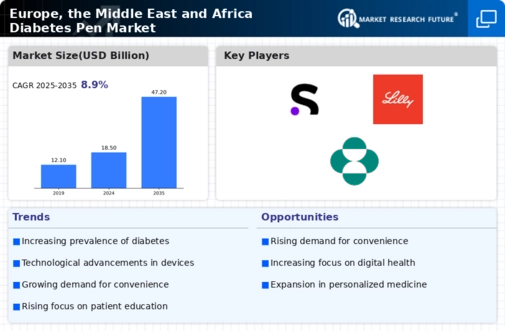Market Analysis
In-depth Analysis of Europe Diabetes Pen Market Industry Landscape
The EUROPE DIABETES PEN market is a pivotal component of diabetes management, providing a convenient and user-friendly method for insulin delivery. Understanding the market dynamics is crucial for manufacturers and healthcare professionals seeking to address the diverse needs of patients across Europe. The prevalence of diabetes in Europe is a significant driver for the demand for diabetes pens. As the number of individuals diagnosed with diabetes continues to rise, there is a growing need for effective and accessible insulin delivery solutions. One of the most preferred insulin delivery methods for diabetic patients is diabetes pens because they are easy to use, convenient and portable. Patient preference for pens over classic vial and syringe approach encourages the adoption of this technology; hence, patient preferences affect market dynamics. Technology is constantly improving with advances in diabetes pen design improve function and usability. The development of insulin pens that are smart and can track dosages, have Bluetooth connectivity along with integrated mobile apps has helped in furthering the market dynamics making treatment more patient centric. The market is molded by the overall movement of home-based healthcare. As a means of self-administration, diabetes pens cater to the trend towards insulin administration at home and offer patients an easier way of managing their condition. Diabetes pens that offer individualized dosing and can accommodate for the variability in insulin needs of patients affect market outlook. Pen manufactures are working to make pens that come up with different insulin quantities allowing not only health care providers but also patients some wiggle room. Education of the healthcare practitioners and patients on advantages diabetes pens use have played a significant role in shaping market dynamics. Awareness also promotes acceptance as well understanding, and driving increased adoption rates in all areas of healthcare across the continent. The market is largely shaped by the regulatory landscape in Europe. Producers need to follow the European Medicines Agency (EMA) regulations and other standards for their products towards obtaining approval of their product as well accessing market. The structure of reimbursement policies and healthcare financing systems in the European countries affect affordable access to diabetic pens. These reimbursement structures are understood and navigated by the manufacturers because addressing market dynamics in an effective manner requires this. The market is competitive in the sense that various primary players offer a selection of diabetes pens. This competitive landscape can be attributed to a pen design, dose accuracy and additional functionalities including which are used by manufacturers as their points of differentiation. Demographic factors such as the aging population in Europe contribute to demand for diabetes pens. This is due to the fact that as the elderly population of people with diabetes also rises, there are more requirements for insulin delivery devices that meet older adults’ likes. Continuous innovation is a driving force in the market dynamics. Manufacturers invest in research and development to introduce new features, materials, and technologies, ensuring that diabetes pens remain at the forefront of insulin delivery solutions. The market is segmented based on factors such as pen type, distribution channels, and end-users. Understanding these segments is crucial for manufacturers to tailor their products to specific patient demographics and healthcare settings.






Leave a Comment